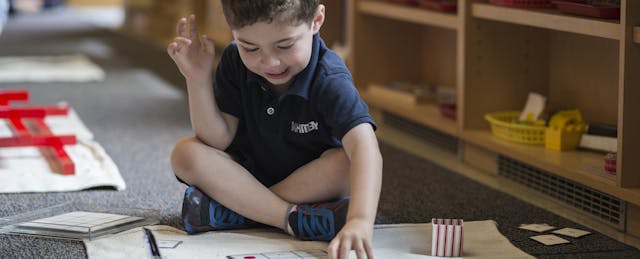The first thing you'll notice when stepping into Malina Marshall's preschool classroom is the size of the furniture. You'll feel like Gulliver arriving at the land of Lilliput. The tables, chairs, sofa, sink, coat rack, cubbies and bookshelves are all miniature versions of the their adult-sized counterparts.
This, in and of itself, is not that unusual of a sight to see in a preschool classroom. The thing you will notice next though is much more impressive: a room full of self-directed two-year olds purposefully going about their work cycle.
Children get their own snacks from the counter, sit at a table and eat while conversing with their neighbors. They hang their coats on hooks with independence, don smocks for painting, quietly read books on the sofa or work with classmates on a activity on the rug. Their teachers are spread around the room observing and waiting for the perfect opportunity to take advantage of a teachable moment.
This is a quintessential Montessori classroom where students are at the center of the action and teachers are more like facilitators.

Down the hall from Marshall’s classroom, a class of fourth graders is equally engaged in their individual work cycles. Some students independently read self-selected books, some do research on their laptops or tablets, and others work on an activity in a small group with their teacher. Students are spread across the classroom and the one thing that is immediately apparent is the non-traditional layout. There is no "front" of this classroom because there are no rows of desks.
You might be thinking: this is a fourth grade Montessori classroom—but it’s actually a quintessential International Baccalaureate (IB) classroom.

These are two of the 27 classes that make up the Whitby School in Greenwich, CT, which was the first school in the world to combine the Montessori approach, which has existed for over 100 years with the IB approach, which was founded in the 1960’s. Despite some obvious differences such as Montessori’s practice of multi-age classrooms or IB’s focus on learner profile traits, these classrooms are so similar because their core philosophies are complementary.
Montessori's age-old approach to nurturing independence and IB's progressive approach to promoting student ownership of the learning process are more relevant now to educational reform in America than ever before.
Personalized learning has become trendy in the wake of modern developments in educational technology, but the current trend is rooted in many of the practices and techniques found in Montessori and IB classrooms. Though there are many interpretations of the term, our school uses the U.S. Department of Education’s definition, which is focused on the individual learner's interests and needs.
The idea that learning should always be optimized for each student is, and has always been, a fundamental part of both Montessori and IB practice. As schools begin to implement new personalized learning initiatives or seek to enhance existing ones, educators and school leaders can look to these five core elements of Montessori and IB approaches for guidance.
1) “Follow the Child”
You can visit any Montessori school in the world and hear this saying spoken as a matter of course because it is Montessori canon. The concept is deceptively simple but can be hard to achieve for teachers and parents alike because adults often just can't help but interfere in a child's play. The idea of follow the child is based on the notion that children have their own agendas that need to be respected. A teacher's role is to prepare an environment for meaningful play and to follow the child as they move about the classroom waiting for teachable moments or opportunities to support the child without impinging on their sense of independence.
2) Inquiry-based learning
A child's natural inclination is to ask questions to help them make sense of the world.Inquiry-based learning harnesses the power of children's natural curiosity to promote meaningful learning. In an IB classroom, inquiry-based learning does more than promote wondering, it sets students up for a lifetime of learning by teaching them to both ask questions and find answers, which promotes student agency. At our school, teachers launch each unit with a central idea and have students ask questions, which are then developed into lines of inquiry. These lines of inquiry shape the curriculum.

3) Student-Centered Classrooms
In an effort to support student-centered learning environments, Montessori and IB classrooms avoid traditional classroom layouts, which establish a front of the room that faces the teacher. Student-centered classrooms are defined by more than just the physical layout of the furniture. They are designed to encourage community, promote responsibility and democratize both access to resources as well as the process of defining the rules of engagement.
4) Rubric-Based Assessments
In IB classrooms, rubrics are used extensively to empower students to assess themselves and engage in meta learning. Rubric-based formative assessments help students gauge where they are at in their understanding of a concept before the teaching even begins. This strategy informs both curriculum development and delivery.
5) Approaches to Learning (ATLs)
The IB's Middle Year's Program introduces the concept of Approaches to Learning (ATLs) to teach students how to learn. ATLs are a collection of skills broken into the following five categories: communication, social, self-management, research and thinking which are broken down further into skill clusters. These ATLs are designed to help students understand themselves as learners and to provide a framework for students to assess the effectiveness of their own learning strategies.
Though the concepts above are typically found in Montessori and IB classrooms, they can be applied to any classroom in an effort to make learning personal for students. So if you’re on a mission to make learning personal at your school, remember that although the idea of personalized learning is getting a lot of attention these days, it is really an amalgamation of approaches that have been practiced and refined for a long time.

Tim Schwartz is the director of innovation at Whitby School in Greenwich, CT.


